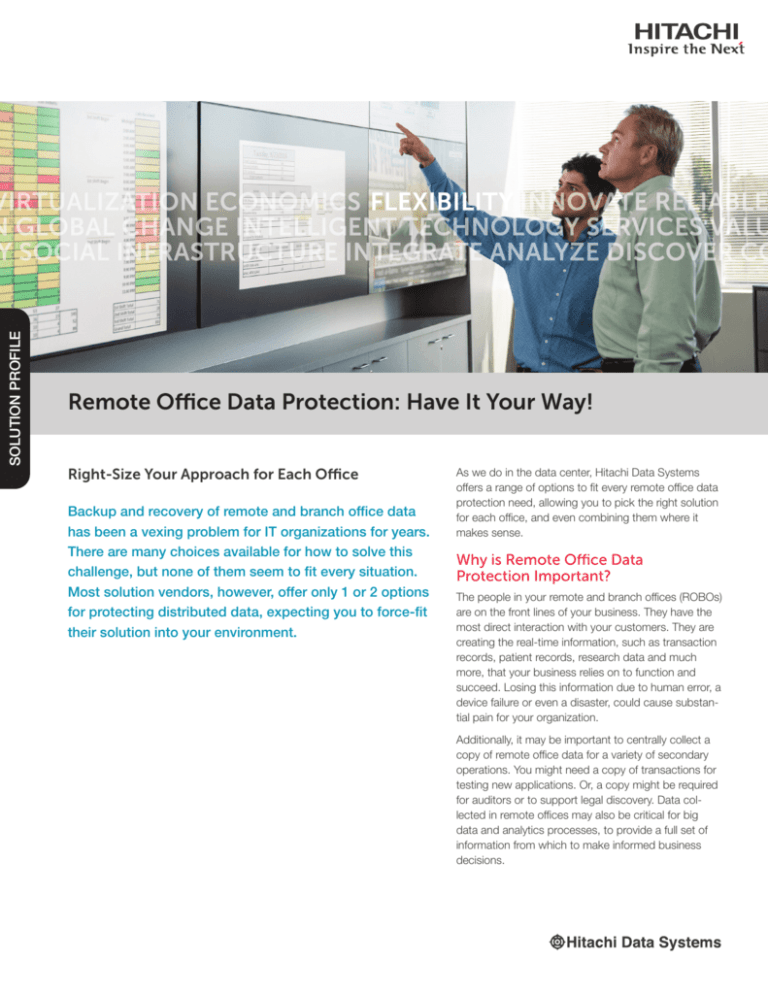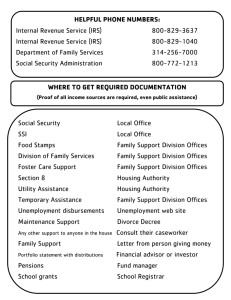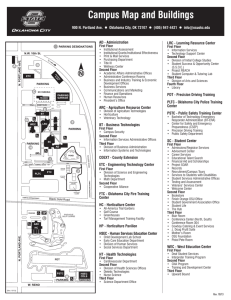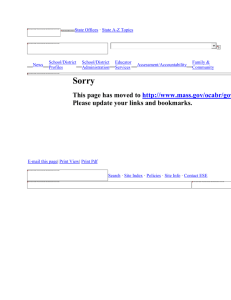
SOLUTION PROFILE
Remote Office Data Protection: Have It Your Way!
Right-Size Your Approach for Each Office
Backup and recovery of remote and branch office data
has been a vexing problem for IT organizations for years.
There are many choices available for how to solve this
challenge, but none of them seem to fit every situation.
Most solution vendors, however, offer only 1 or 2 options
for protecting distributed data, expecting you to force-fit
their solution into your environment.
As we do in the data center, Hitachi Data Systems
offers a range of options to fit every remote office data
protection need, allowing you to pick the right solution
for each office, and even combining them where it
makes sense.
Why is Remote Office Data
Protection Important?
The people in your remote and branch offices (ROBOs)
are on the front lines of your business. They have the
most direct interaction with your customers. They are
creating the real-time information, such as transaction
records, patient records, research data and much
more, that your business relies on to function and
succeed. Losing this information due to human error, a
device failure or even a disaster, could cause substantial pain for your organization.
Additionally, it may be important to centrally collect a
copy of remote office data for a variety of secondary
operations. You might need a copy of transactions for
testing new applications. Or, a copy might be required
for auditors or to support legal discovery. Data collected in remote offices may also be critical for big
data and analytics processes, to provide a full set of
information from which to make informed business
decisions.
SOLUTION PROFILE
Why Is Remote Office Data
Protection So Challenging?
Just as in the corporate
Unified
offices and in the data
Recovery
center, there are different
Management
types of applications and
WATCH
data created and stored in
remote offices. However,
unlike the core sites, remote offices don’t
usually have dedicated technical staff to
help manage data storage and protection.
In fact, data management is so far from the
mission of remote staff that they don’t even
want to think about it, much less do it.
At best, you might have someone, maybe an
office manager, who is tasked with starting
a backup job before he or she heads home
each night. That individual then sends a
copy of the backup data to an off-site facility,
or your data center, for disaster recovery
and/or archiving. Or, you rely on a local services company to handle these tasks.
Even more challenging is the home office
worker. According to GlobalWorkplace
Analytics.com, as many as 3.3 million
employees in the U.S., or 2.6% of the total
workforce, consider their home to be their
primary place of work. This number grew
almost 80% between 2005 and 2012,
indicating that this is an important segment
of the data management spectrum and
requires the attention of those tasked with
data protection, recovery and retention.
Figure 1. Data Protection for Small Offices
Figure 2. Data Protection in VDI Environments
■■
Why Doesn’t One Solution
Work Everywhere?
Frankly, it’s because there are different sizes
and types of remote offices:
■■
■■
■■
Small offices of 1 to 10 employees,
including home offices and mobile
employees, do not have a local IT infrastructure beyond user workstations and a
network connection.
Medium-size offices may have 10 to 50
employees, with some shared infrastructure, such as an application server, a file
server and maybe an email server.
Larger offices with 50 or more staff members would have a larger infrastructure
and probably one or two local staff, who
handle IT support as a part of their job.
Regional offices, with a mixture of functions that focus both locally and across
a geography, could have needs that are
blend of the above.
A single approach to solve all these situations is most likely to be too expensive for
the smaller offices and not effective for the
larger ones.
Hitachi Data Systems and
ROBO Cloud
our partners will help you
Solution
choose the right technology,
Profile
or set of technologies, for
READ
each of your ROBOs, and
tie it all together to work with
your core data protection
infrastructure. Right-sizing the solution will
also right-size the cost, effectiveness and
return on investment.
Examples of Possible Remote
Office Data Protection
Solutions
For small offices (see Figure 1) with
no shared infrastructure, the preferred
approach is to install a backup agent onto
each employee’s desktop or laptop system.
For example, if you are using Hitachi Data
Protection Suite (HDPS) in your data center,
it can provide backup and recovery for the
users that is:
■■
Centrally managed and fully automated.
■■
Deployed and installed remotely.
■■
Integrated with data center backup,
disaster recovery and archiving.
3
ROBO data as well as other tiered data. It
is self-protected storage, so no backup is
needed here, either.
Larger offices (see Figure
Insightful
4) can host their own data
HDID
protection infrastructure.
White Paper
However, you will still want
DOWNLOAD
to centrally manage this
environment and have it run
automatically, so that it is transparent and
not a burden to your remote staff. Hitachi
Data Instance Director (HDID) provides this
and is fully policy-based to allow different
levels of protection for different data sets.
HDID is a unified copy data management
solution that integrates backup, continuous
data protection, snapshots, replication and
archive (tiering to HCP in the data center)
in a single easy-to-use interface. Since it
performs block-level, incremental-forever
data capture it has little or no impact on
applications.
Figure 3. Data Protection for Medium-Size Offices
Figure 4. Data Protection for Large Offices
A recent trend for the smallest offices,
including the home office, is to use virtual
desktop infrastructure (VDI), replacing the
traditional client-server model. This technology approach is very similar to the “dumb”
terminal of the 1960s and 1970s, when all
applications and data were served from a
central mainframe or minicomputer. The
terminal was simply a screen, a keyboard
and a connection to the computer.
In the Hitachi Data Systems solution for VDI,
the user data is stored in Hitachi Content
Platform (HCP) object storage. HCP
includes sophisticated self-protecting capabilities, eliminating the need for traditional
backup. Likewise, using stateless VMs
in a centralized Hitachi Unified Compute
Platform (UCP) requires only a copy of the
VM to be stored off-site for disaster recovery capabilities.
As shown in Figure 2, the mainframe is
replaced by a centralized virtual machine
(VM) infrastructure and a centralized data
store. The VM stores and easily protects
the “stateless” user operating systems and
applications and serves them to the VDI
endpoint. The data store maintains, manages and serves the VDI machine state
information and the user’s data.
For medium-size offices (see Figure 3),
an excellent option is to use a combination
of Hitachi Data Ingestor (HDI) in the remote
office and Hitachi Content Platform in the
data center. HDI is a remote office NAS
file server. Its data is automatically copied
to the central HCP system. No backup
is required in the remote office. HCP is a
highly scalable object storage platform
that can centrally store and manage all
For regional offices (see Figure 5) that
may have a blend of geographical and local
responsibilities, a blended solution could be
the most practical. For example, you would
use HDID to protect application data, such
as Microsoft® SQL Server® or Exchange.
Use the HDID storage-based snapshot and
clone support, or block-level continuous
data protection (CDP), plus asynchronous
replication to a central HDID server for
disaster recovery. Also use HDI and HCP
for file data, and HDPS for mobile users.
Simply mix and match as needed.
Summary
Everything about information technology
is complicated, especially at enterprise
scale. Even though a remote office may
seem like a more simple entity than a huge
data center, protecting the data in that
office is no less important. Choosing the
right solution is not a simple decision. Each
office has different characteristics, including
applications, data sets, infrastructure and
network connectivity, number and function
of employees, not to mention the technical
skills of the staff in that office.
Given the importance of the data being
created and managed in these distributed
locations, it is incumbent upon the central
IT office to ensure the remote data is protected, managed and retained in a manner
SOLUTION PROFILE
that is consistent with corporate and regulatory policies. Expecting the employees
in these offices to take time from their day
jobs to perform data protection processes
is naïve at best. A centrally managed and
monitored approach is what’s really needed,
but with a range of technology options that
can be adapted to the local requirements.
Figure 5. Data Protection for Regional Offices
The data protection experts at Hitachi
Data Systems can help you define, design
and implement a solution, or set of solutions, to this complex problem. Together,
we’ll deploy the technologies that are just
right for your organization, meeting the
data protection and recovery service level
requirements of each office.
To begin this conversation, please contact
DP-Sales@HDS.com.
Corporate Headquarters
2845 Lafayette Street
Santa Clara, CA 95050-2639 USA
www.HDS.com community.HDS.com
Regional Contact Information
Americas: 866 374 5822 or info@hds.com
Europe, Middle East and Africa: +44 (0) 1753 618000 or info.emea@hds.com
Asia Pacific: +852 3189 7900 or hds.marketing.apac@hds.com
© Hitachi Data Systems Corporation 2015. All rights reserved. HITACHI is a trademark or registered trademark of Hitachi, Ltd. Microsoft and SQL Server are trademarks or registered
trademarks of Microsoft Corporation. All other trademarks, service marks, and company names are properties of their respective owners.
SP-188-B DG July 2015







